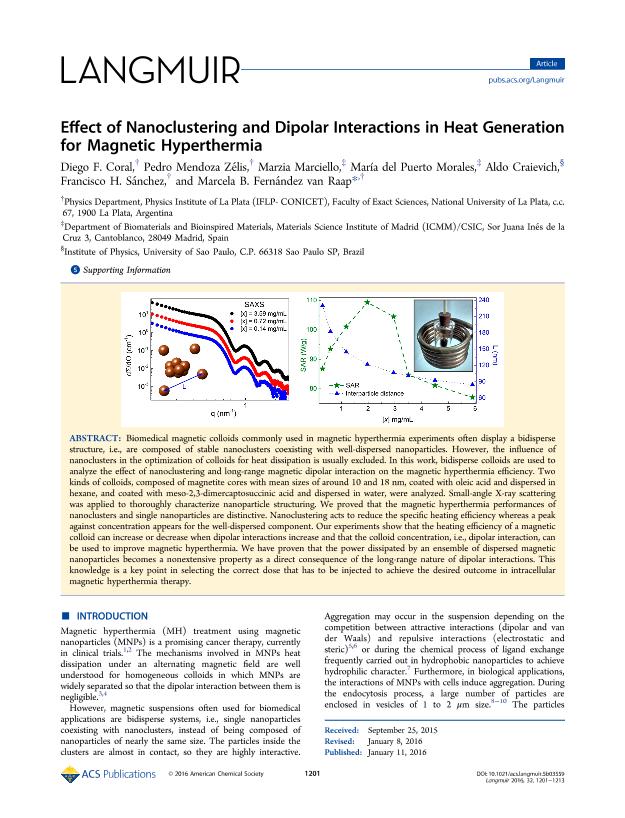Mostrar el registro sencillo del ítem
dc.contributor.author
Coral, Diego Fernando

dc.contributor.author
Mendoza Zélis, Pedro

dc.contributor.author
Marciello, Marzia
dc.contributor.author
Morales, María Del Puerto
dc.contributor.author
Craievich, Aldo
dc.contributor.author
Sánchez, Francisco Homero

dc.contributor.author
Fernández van Raap, Marcela Beatriz

dc.date.available
2018-08-10T00:04:16Z
dc.date.issued
2016-02
dc.identifier.citation
Coral, Diego Fernando; Mendoza Zélis, Pedro; Marciello, Marzia; Morales, María Del Puerto; Craievich, Aldo; et al.; Effect of Nanoclustering and Dipolar Interactions in Heat Generation for Magnetic Hyperthermia; American Chemical Society; Langmuir; 32; 5; 2-2016; 1201-1213
dc.identifier.issn
0743-7463
dc.identifier.uri
http://hdl.handle.net/11336/54927
dc.description.abstract
Biomedical magnetic colloids commonly used in magnetic hyperthermia experiments often display a bidisperse structure, i.e., are composed of stable nanoclusters coexisting with well-dispersed nanoparticles. However, the influence of nanoclusters in the optimization of colloids for heat dissipation is usually excluded. In this work, bidisperse colloids are used to analyze the effect of nanoclustering and long-range magnetic dipolar interaction on the magnetic hyperthermia efficiency. Two kinds of colloids, composed of magnetite cores with mean sizes of around 10 and 18 nm, coated with oleic acid and dispersed in hexane, and coated with meso-2,3-dimercaptosuccinic acid and dispersed in water, were analyzed. Small-angle X-ray scattering was applied to thoroughly characterize nanoparticle structuring. We proved that the magnetic hyperthermia performances of nanoclusters and single nanoparticles are distinctive. Nanoclustering acts to reduce the specific heating efficiency whereas a peak against concentration appears for the well-dispersed component. Our experiments show that the heating efficiency of a magnetic colloid can increase or decrease when dipolar interactions increase and that the colloid concentration, i.e., dipolar interaction, can be used to improve magnetic hyperthermia. We have proven that the power dissipated by an ensemble of dispersed magnetic nanoparticles becomes a nonextensive property as a direct consequence of the long-range nature of dipolar interactions. This knowledge is a key point in selecting the correct dose that has to be injected to achieve the desired outcome in intracellular magnetic hyperthermia therapy.
dc.format
application/pdf
dc.language.iso
eng
dc.publisher
American Chemical Society

dc.rights
info:eu-repo/semantics/openAccess
dc.rights.uri
https://creativecommons.org/licenses/by-nc-sa/2.5/ar/
dc.subject
Magnetic Colloids
dc.subject
Magnetic Hyperthermia
dc.subject
Saxs
dc.subject
Biomedical Aplications
dc.subject.classification
Astronomía

dc.subject.classification
Ciencias Físicas

dc.subject.classification
CIENCIAS NATURALES Y EXACTAS

dc.title
Effect of Nanoclustering and Dipolar Interactions in Heat Generation for Magnetic Hyperthermia
dc.type
info:eu-repo/semantics/article
dc.type
info:ar-repo/semantics/artículo
dc.type
info:eu-repo/semantics/publishedVersion
dc.date.updated
2018-07-31T17:22:20Z
dc.journal.volume
32
dc.journal.number
5
dc.journal.pagination
1201-1213
dc.journal.pais
Estados Unidos

dc.journal.ciudad
Washington DC
dc.description.fil
Fil: Coral, Diego Fernando. Consejo Nacional de Investigaciones Científicas y Técnicas. Centro Científico Tecnológico Conicet - La Plata. Instituto de Física La Plata. Universidad Nacional de La Plata. Facultad de Ciencias Exactas. Instituto de Física La Plata; Argentina
dc.description.fil
Fil: Mendoza Zélis, Pedro. Consejo Nacional de Investigaciones Científicas y Técnicas. Centro Científico Tecnológico Conicet - La Plata. Instituto de Física La Plata. Universidad Nacional de La Plata. Facultad de Ciencias Exactas. Instituto de Física La Plata; Argentina
dc.description.fil
Fil: Marciello, Marzia. Instituto de Ciencia de Materiales de Madrid; España. Consejo Superior de Investigaciones Científicas; España
dc.description.fil
Fil: Morales, María Del Puerto. Instituto de Ciencia de Materiales de Madrid; España. Consejo Superior de Investigaciones Científicas; España
dc.description.fil
Fil: Craievich, Aldo. Universidade de Sao Paulo; Brasil
dc.description.fil
Fil: Sánchez, Francisco Homero. Consejo Nacional de Investigaciones Científicas y Técnicas. Centro Científico Tecnológico Conicet - La Plata. Instituto de Física La Plata. Universidad Nacional de La Plata. Facultad de Ciencias Exactas. Instituto de Física La Plata; Argentina
dc.description.fil
Fil: Fernández van Raap, Marcela Beatriz. Consejo Nacional de Investigaciones Científicas y Técnicas. Centro Científico Tecnológico Conicet - La Plata. Instituto de Física La Plata. Universidad Nacional de La Plata. Facultad de Ciencias Exactas. Instituto de Física La Plata; Argentina
dc.journal.title
Langmuir

dc.relation.alternativeid
info:eu-repo/semantics/altIdentifier/doi/http://dx.doi.org/10.1021/acs.langmuir.5b03559
dc.relation.alternativeid
info:eu-repo/semantics/altIdentifier/url/https://pubs.acs.org/doi/10.1021/acs.langmuir.5b03559
Archivos asociados
